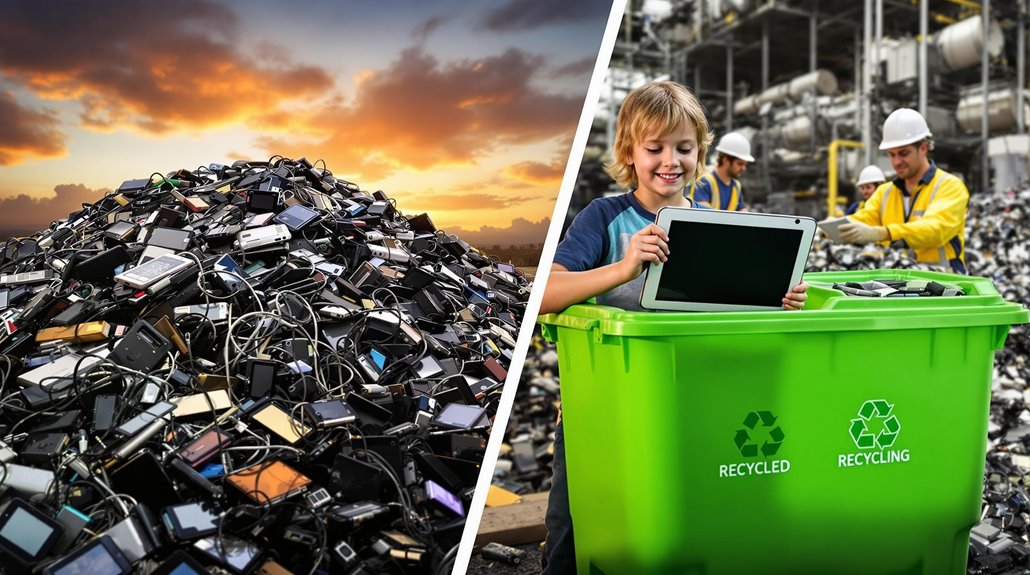Recycling electronics prevents toxic substances such as lead and mercury from contaminating soil and water systems. Old devices contain valuable materials—motherboards have 800 times more gold than mined ore. Proper e-waste management reduces the need for destructive mining operations while recovering precious metals with 95% efficiency. Many communities offer designated collection sites or take-back programs for safe disposal. Uncovering what happens to these materials after disposal reveals the true impact of responsible recycling.
The Hidden Dangers of Tossing Electronics in the Trash

Every electronic device discarded in regular trash contributes to a growing environmental and health crisis. As electronics end up in landfills, toxic substances including mercury, lead, cadmium, and lithium leach into soil and groundwater, contaminating ecosystems for decades.
These chemicals don’t simply disappear; they migrate through water systems, transform into more dangerous compounds such as methylmercury, and eventually enter food chains. The consequences extend beyond environmental damage to serious human health risks, including brain damage, kidney failure, and neurological disorders.
Even more concerning, the improper processing of e-waste—such as burning or shredding without proper safeguards—releases carcinogens and fine particles into the air, greatly increasing cancer and respiratory disease risks for surrounding communities.
Valuable Treasures Inside Your Unwanted Devices
Hidden beneath the plastic shells and metal frames of discarded electronics, valuable metals await recovery and repurposing. These devices contain significant concentrations of precious metals—motherboards hold 800 times more gold than mined ore, while components such as CPUs and connectors contain platinum, silver, and palladium. One million recycled phones yield approximately 75 pounds of gold, 35,000 pounds of copper, and 800 pounds of silver.
The most valuable components for recycling include:
When hunting for precious metals in e-waste, focus on CPUs, gold-rich motherboards, and plated connectors.
- CPUs and processors (highest gold concentration)
- Motherboards (rich in various precious metals)
- Gold-plated connectors and pins (reliable sources of recoverable gold)
Proper e-waste recycling not only prevents toxic materials from entering landfills but transforms obsolete technology into valuable resources. This process conserves raw materials, reduces greenhouse gas emissions, and creates a sustainable technology lifecycle that benefits both the planet and resource efficiency.
How Responsible E-Waste Recycling Protects Our Planet

Since electronic waste continues to accumulate at alarming rates, responsible recycling practices offer essential protection for environmental health and sustainability. Proper e-waste processing prevents toxic substances such as lead, mercury, and cadmium from contaminating soil and water systems, where they can persist for generations.
When electronics end up in landfills—as 80% currently do—these toxins eventually leach into groundwater or release into the air through incineration. Recycling not only prevents this contamination but also reduces the need for resource-intensive mining operations that destroy habitats and pollute waterways.
The benefits extend beyond pollution prevention. Recycled materials require considerably less energy to process than raw ones, conserving water and reducing carbon emissions. This “urban mining” recovers valuable metals with 95% efficiency, creating a sustainable alternative to destructive extraction practices. Following sustainable disposal practices helps minimize environmental impact while maximizing resource recovery from electronic waste.
The Path Forward: Taking Action on Electronic Waste
Addressing the electronic waste challenge requires concrete action at individual, corporate, and governmental levels. Consumers can participate in take-back programs and seek certified recyclers, while companies increasingly design products for easier disassembly and material recovery.
Three effective approaches to managing e-waste include:
Smart e-waste management demands refurbishment, sustainable manufacturing partnerships, and advocacy for producer responsibility legislation.
- Supporting refurbishment programs that extend device lifespans and provide technology to underserved communities
- Choosing manufacturers with established recycling initiatives and sustainable design practices
- Advocating for stronger legislation that holds producers responsible for the entire lifecycle of their products
AI-driven sorting technologies and chemical recycling methods represent promising innovations that maximize resource recovery while minimizing environmental harm. With 25 states now implementing e-waste laws and global frameworks such as the Basel Convention providing oversight, the infrastructure for responsible electronics disposal continues to strengthen.
Frequently Asked Questions
How Long Does E-Waste Take to Decompose in Landfills?
Glass: 1-2 million years
Plastics: 20-1,000,000+ years
Metals: Several decades to centuries
Where Can I Find Certified E-Waste Recycling Centers Near Me?
Search certified e-waste recyclers through R2, e-Stewards, or GreenerGadgets directories, or contact local recycling facilities for disposal services.
Can I Get Paid for Recycling My Old Electronics?
Yes. Recycle electronics for payment via SellCell, Gizmogo, ecoATM, Amazon Trade-In, and Decluttr. Newer, working devices earn more through manufacturer trade-ins.
Are There Tax Benefits for Businesses That Recycle Electronics?
Yes. Businesses can claim:
- Federal/state tax credits for recycling equipment
- Direct tax refunds
- Operational cost reductions through certified e-recycling programs
How Can I Securely Erase Data Before Recycling Devices?
Use secure erasure software to overwrite data multiple times, physically destroy storage devices, or degauss magnetic media. Factory resets do not ensure complete data removal.
References
- https://sadoffelectronicsrecycling.com/blog/9-e-recycling-stats-environmental-benefits/
- https://www.theenvironmentalblog.org/2020/10/8-reasons-why-you-should-start-properly-recycling-your-e-waste-today/
- https://alianzarecycling.com/resources/e-waste-statistics/
- https://hummingbirdinternational.net/reasons-to-recycle-ewaste/
- https://earth.org/e-waste-recycling-rates-remain-dangerously-low-as-demand-for-electronic-devices-booms-un-report-reveals/
- https://elytus.com/blog/e-waste-and-its-negative-effects-on-the-environment.html
- https://www.ewaste1.com/top-barriers-to-e-waste-recycling/
- https://www.elianelectronicsrecycling.com/post/the-hidden-dangers-of-e-waste
- https://sadoffelectronicsrecycling.com/blog/why-is-most-electronic-waste-not-recycled-phc/
- https://www.ewaste1.com/hazards-of-dumping-electronic-waste/

